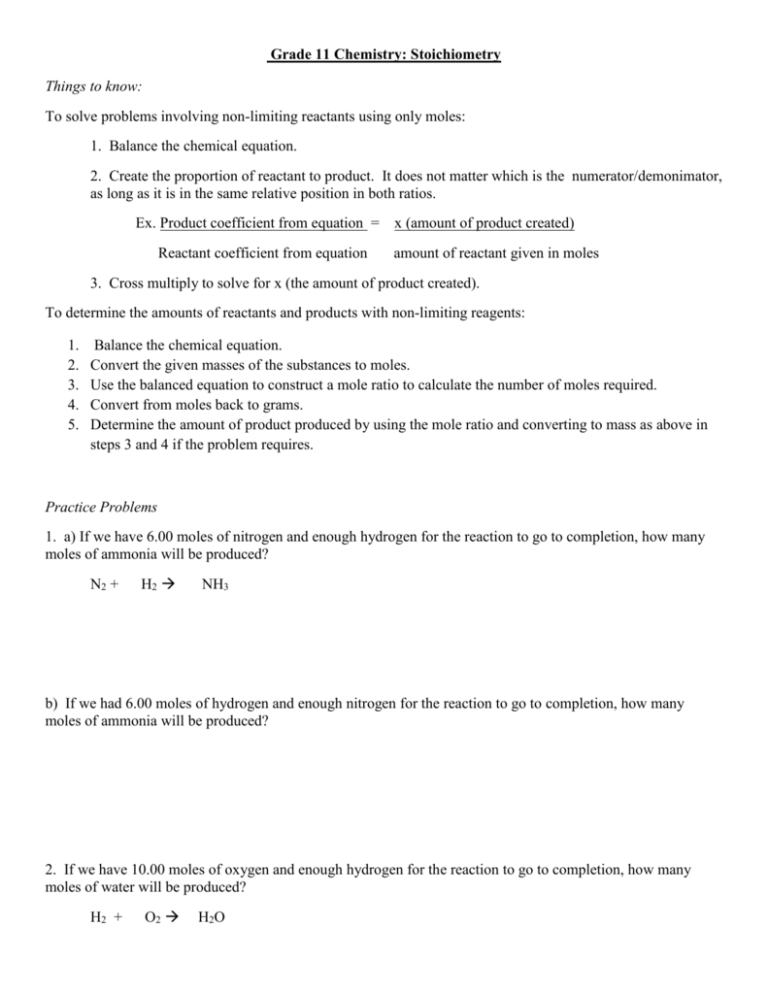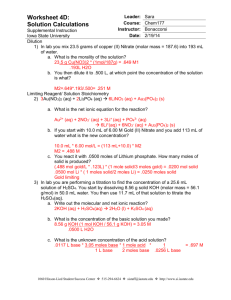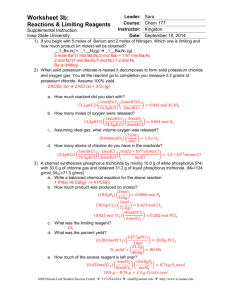Stoichiometry Worksheet: Moles & Limiting Reagents
advertisement

Grade 11 Chemistry: Stoichiometry Things to know: To solve problems involving non-limiting reactants using only moles: 1. Balance the chemical equation. 2. Create the proportion of reactant to product. It does not matter which is the numerator/demonimator, as long as it is in the same relative position in both ratios. Ex. Product coefficient from equation = x (amount of product created) Reactant coefficient from equation amount of reactant given in moles 3. Cross multiply to solve for x (the amount of product created). To determine the amounts of reactants and products with non-limiting reagents: 1. 2. 3. 4. 5. Balance the chemical equation. Convert the given masses of the substances to moles. Use the balanced equation to construct a mole ratio to calculate the number of moles required. Convert from moles back to grams. Determine the amount of product produced by using the mole ratio and converting to mass as above in steps 3 and 4 if the problem requires. Practice Problems 1. a) If we have 6.00 moles of nitrogen and enough hydrogen for the reaction to go to completion, how many moles of ammonia will be produced? N2 + H2 NH3 b) If we had 6.00 moles of hydrogen and enough nitrogen for the reaction to go to completion, how many moles of ammonia will be produced? 2. If we have 10.00 moles of oxygen and enough hydrogen for the reaction to go to completion, how many moles of water will be produced? H2 + O2 H2O b) If 6.00 moles of water is produced, how much oxygen was consumed? How much hydrogen was consumed? 3. What mass of oxygen will react with 100g of propane? C3H8(g) + ___O2(g) ___CO2(g) + ___H2O(g) a) How many moles of propane are present in 100g of propane? 100 g C3H8 x ___ mol C3H8 _____ = _____ mol C3H8 g C3H8 b) How many moles of oxygen react with 1 mol of propane? ___ mol O2 1 mol C3H8 c) How many grams of oxygen react with 100g of propane? ______ mol O2 x ______g O2 = _________ g O2 mol O2 d) How many grams of CO2 are produced? ______ mol C3H8 x ___mol CO2 = _____ mol CO2 mol C3H8 _____ mol CO2 x ____g CO2 = ______g CO2 mol CO2 4. a) What mass of oxygen will reaction with 27.3g of C8H18? C8H18 + O2 CO2 + H2O b) What masses of carbon dioxide and water are produced? 5. a) How many moles of chlorine gas (Cl2) would react with 5 moles of sodium (Na) according to the following chemical equation? Na(s) + Cl2 (g) --> NaCl(g) b) Determine the amount of product that can be produced from 24.7 g Na. 6. KClO3 decomposes to produce KCl and O2. a) What is the balanced chemical equation for this process? b) If 1.8 moles of KClO3 decomposes, how much O2 is produced? c) If 96 g of O2 was produced, how much KClO3 decomposed? Stiociometry Problems Involving a Limiting Reagent To determine the amounts of reactions and products with a limiting reagent: 1. Balance the chemical equation. 2. Convert the given masses of the substances to moles. 3. Use the balanced equation to construct a mole ratio to calculate the number of moles actually present to determine which reactant is limiting. 4. Determine the number of moles of the product using the amount of the limiting reagent and mole ratio. 5. Convert from moles back to grams. 6. Determine the percent yield if the problem requires. 1. Aluminum reacts with iodine to produce Aluminum iodide according to the following equation: 2 Al + 3 I2 2AlI3 Determine the limiting reactant and theoretical yield of AlI3 if: a) you have 1.20 mol Al and 2.40 mol I b) 1.20 g al and 2.40 g I c) How much excess reagent (and which one) do you have at the end of the reaction? d) In the lab you produce 0.005g of product. What is the percent yield? 2. You have 30 g Al2S3 and 20 g water, which react to form Al(OH)3 and H2S Al2S3 + H2O Al(OH)3 + H2S a) What is the limiting reactant? b) What is the maximum amount of H2S that can be formed? c) How much excess reagent will you have left over? 3. Determine the mass of ammonia produced when 25.0g of nitrogen and 5.0g of hydrogen are mixed. a) Balance the equation. N2(g) + H2(g) NH3(g) b) Determine the limiting reagent. c) Determine the number of moles of ammonia formed. d) Determine the mass of ammonia formed. 4. If 15.2 kg of NH3 is reacted with 75.8 kg of CuO, which is the limiting reagent? How many kilograms of N2 will be formed? NH3(g) + CuO(g) N2(g) + Cu(s) + H2O(g)







